#Baber Unit
Explore tagged Tumblr posts
Text
Buy Classic Baber Unit & Beauty Salon Interior Furniture
We have a wide range of classic Baber units & Beauty Salon Furniture Interior units. Purewood also provides you with the best Barber Furniture Online. From Baber to Purewood, we are committed to providing the highest quality products and services to our customers. If you're looking for classic barber furniture, look no further than Purewood. We have a wide range of classic Baber units and Beauty Salon Furniture Interior units. Purewood also provides you with the best Barber Furniture Online. We've got you covered. We know that you're looking for the best Barber Furniture online, and we want to help. We have a wide range of classic Baber units & Beauty Salon Furniture Interior units. Purewood also provides you with the best Barber Furniture Online.
#Beauty Salon Interior Furniture#Salon Interior Furniture#Salon#Furniture#Baber Unit#barber furniture
1 note
·
View note
Text

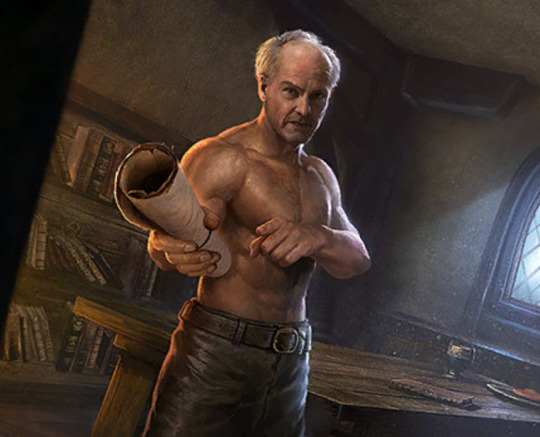
imperialism and science reading list
edited: by popular demand, now with much longer list of books
Of course Katherine McKittrick and Kathryn Yusoff.
People like Achille Mbembe, Pratik Chakrabarti, Rohan Deb Roy, Lizabeth Paravisini-Gebert, and Elizabeth Povinelli have written some “classics” and they track the history/historiography of US/European scientific institutions and their origins in extraction, plantations, race/slavery, etc.
Two articles I’d recommend as a summary/primer:
Zaheer Baber. “The Plants of Empire: Botanic Gardens, Colonial Power and Botanical Knowledge.” Journal of Contemporary Asia. May 2016.
Kathryn Yusoff. “The Inhumanities.” Annals of the American Association of Geographers. 2020.
Then probably:
Irene Peano, Marta Macedo, and Colette Le Petitcorps. “Introduction: Viewing Plantations at the Intersection of Political Ecologies and Multiple Space-Times.” Global Plantations in the Modern World: Sovereignties, Ecologies, Afterlives. 2023.
Sharae Deckard. “Paradise Discourse, Imperialism, and Globalization: Exploiting Eden.” 2010. (Chornological overview of development of knowledge/institutions in relationship with race, slavery, profit as European empires encountered new lands and peoples.)
Gregg Mitman. “Forgotten Paths of Empire: Ecology, Disease, and Commerce in the Making of Liberia’s Plantation Economy.” Environmental History. 2017, (Interesting case study. US corporations were building fruit plantations in Latin America and rubber plantations in West Africa during the 1920s. Medical doctors, researchers, and academics made a strong alliance these corporations to advance their careers and solidify their institutions. By 1914, the director of Harvard’s Department of Tropical Medicine was also simultaneously the director of the Laboratories of the Hospitals of the United Fruit Company, which infamously and brutally occupied Central America. This same Harvard doctor was also a shareholder in rubber plantations, and had a close personal relationship with the Firestone Tire and Rubber Company, which occupied West Africa.)
Elizabeth DeLoughrey. “Globalizing the Routes of Breadfruit and Other Bounties.” 2008. (Case study of how British wealth and industrial development built on botany. Examines Joseph Banks; Kew Gardens; breadfruit; British fear of labor revolts; and the simultaneous colonizing of the Caribbean and the South Pacific.)
Elizabeth DeLoughrey. “Satellite Planetarity and the Ends of the Earth.” 2014. (Indigenous knowledge systems; “nuclear colonialism”; US empire in the Pacific; space/satellites; the twentieth and twenty-first centuries.)
Fahim Amir. “Cloudy Swords.” e-flux Journal #115, February 2021. (”Pest control”; termites; mosquitoes; fear of malaria and other diseases during German colonization of Africa and US occupations of Panama and the wider Caribbean; origins of some US institutions and the evolution of these institutions into colonial, nationalist, and then NGO forms over twentieth century.)
Some of the earlier generalist classic books that explicitly looked at science as a weapon of empires:
Schiebinger’s Plants and Empire: Colonial Bioprospecting in the Atlantic World; Delbourgo’s and Dew’s Science and Empire in the Atlantic World; the anthology Colonial Botany: Science, Commerce, and Politics in the Early Modern World; Canzares-Esquerra’s Nature, Empire, and Nation: Explorations of the History of Science in the Iberian World.
One of the quintessential case studies of science in the service of empire is the British pursuit of quinine and the inoculation of their soldiers and colonial administrators to safeguard against malaria in Africa, India, and Southeast Asia at the height of their power. But there are so many other exemplary cases: Britain trying to domesticate and transplant breadfruit from the South Pacific to the Caribbean to feed laborers to prevent slave uprisings during the age of the Haitian Revolution. British colonial administrators smuggling knowledge of tea cultivation out of China in order to set up tea plantations in Assam. Eugenics, race science, biological essentialism, etc. in the early twentieth century. With my interests, my little corner of exposure/experience has to do mostly with conceptions of space/place; interspecies/multispecies relationships; borderlands and frontiers; Caribbean; Latin America; islands. So, a lot of these recs are focused there. But someone else would have better recs, especially depending on your interests. For example, Chakrabarti writes about history of medicine/healthcare. Paravisini-Gebert about extinction and Caribbean relationship to animals/landscape. Deb Roy focuses on insects and colonial administration in South Asia. Some scholars focus on the historiography and chronological trajectory of “modernity” or “botany” or “universities/academia,”, while some focus on Early Modern Spain or Victorian Britain or twentieth-century United States by region. With so much to cover, that’s why I’d recommend the articles above, since they’re kinda like overviews.Generally I read more from articles, essays, and anthologies, rather than full-length books.
Some other nice articles:
(On my blog, I’ve got excerpts from all of these articles/essays, if you want to search for or read them.)
Katherine McKittrick. “Dear April: The Aesthetics of Black Miscellanea.” Antipode. First published September 2021.
Katherine McKittrick. “Plantation Futures.” Small Axe. 2013.
Antonio Lafuente and Nuria Valverde. “Linnaean Botany and Spanish Imperial Biopolitics.” A chapter in: Colonial Botany: Science, Commerce, and Politics in the Early Modern World. 2004.
Kathleen Susan Murphy. “A Slaving Surgeon’s Collection: The Pursuit of Natural History through the British Slave Trade to Spanish America.” 2019. And also: “The Slave Trade and Natural Science.” In: Oxford Bibliographies in Atlantic History. 2016.
Timothy J. Yamamura. “Fictions of Science, American Orientalism, and the Alien/Asian of Percival Lowell.” 2017.
Elizabeth Bentley. “Between Extinction and Dispossession: A Rhetorical Historiography of the Last Palestinian Crocodile (1870-1935).” 2021.
Pratik Chakrabarti. “Gondwana and the Politics of Deep Past.” Past & Present 242:1. 2019.
Jonathan Saha. “Colonizing elephants: animal agency, undead capital and imperial science in British Burma.” BJHS Themes. British Society for the History of Science. 2017.
Zoe Chadwick. “Perilous plants, botanical monsters, and (reverse) imperialism in fin-de-siecle literature.” The Victorianist: BAVS Postgraduates. 2017.
Dante Furioso: “Sanitary Imperialism.” Jeremy Lee Wolin: “The Finest Immigration Station in the World.” Serubiri Moses. “A Useful Landscape.” Andrew Herscher and Ana Maria Leon. “At the Border of Decolonization.” All from e-flux.
William Voinot-Baron. “Inescapable Temporalities: Chinook Salmon and the Non-Sovereignty of Co-Management in Southwest Alaska.” 2019.
Rohan Deb Roy. “White ants, empire, and entomo-politics in South Asia.” The Historical Journal. 2 October 2019.
Rohan Deb Roy. “Introduction: Nonhuman Empires.” Comparative Studies of South Asia, Africa and the Middle East 35 (1). May 2015.
Lawrence H. Kessler. “Entomology and Empire: Settler Colonial Science and the Campaign for Hawaiian Annexation.” Arcadia (Spring 2017).
Sasha Litvintseva and Beny Wagner. “Monster as Medium: Experiments in Perception in Early Modern Science and Film.” e-flux. March 2021.
Lesley Green. “The Changing of the Gods of Reason: Cecil John Rhodes, Karoo Fracking, and the Decolonizing of the Anthropocene.” e-flux Journal Issue #65. May 2015.
Martin Mahony. “The Enemy is Nature: Military Machines and Technological Bricolage in Britain’s ‘Great Agricultural Experiment.’“ Environment and Society Portal, Arcadia. Spring 2021.
Anna Boswell. “Anamorphic Ecology, or the Return of the Possum.” 2018. And; “Climates of Change: A Tuatara’s-Eye View.”2020. And: “Settler Sanctuaries and the Stoat-Free State." 2017.
Katherine Arnold. “Hydnora Africana: The ‘Hieroglyphic Key’ to Plant Parasitism.” Journal of the History of Ideas - JHI Blog - Dispatches from the Archives. 21 July 2021.
Helen F. Wilson. “Contact zones: Multispecies scholarship through Imperial Eyes.” Environment and Planning. July 2019.
Tom Brooking and Eric Pawson. “Silences of Grass: Retrieving the Role of Pasture Plants in the Development of New Zealand and the British Empire.” The Journal of Imperial and Commonwealth History. August 2007.
Kirsten Greer. “Zoogeography and imperial defence: Tracing the contours of the Neactic region in the temperate North Atlantic, 1838-1880s.” Geoforum Volume 65. October 2015. And: “Geopolitics and the Avian Imperial Archive: The Zoogeography of Region-Making in the Nineteenth-Century British Mediterranean.” Annals of the Association of American Geographers. 2013,
Marco Chivalan Carrillo and Silvia Posocco. “Against Extraction in Guatemala: Multispecies Strategies in Vampiric Times.” International Journal of Postcolonial Studies. April 2020.
Laura Rademaker. “60,000 years is not forever: ‘time revolutions’ and Indigenous pasts.” Postcolonial Studies. September 2021.
Paulo Tavares. “The Geological Imperative: On the Political Ecology of the Amazon’s Deep History.” Architecture in the Anthropocene. Edited by Etienne Turpin. 2013.
Kathryn Yusoff. “Geologic Realism: On the Beach of Geologic Time.” Social Text. 2019. And: “The Anthropocene and Geographies of Geopower.” Handbook on the Geographies of Power. 2018. And: “Climates of sight: Mistaken visbilities, mirages and ‘seeing beyond’ in Antarctica.” In: High Places: Cultural Geographies of Mountains, Ice and Science. 2008. And:“Geosocial Formations and the Anthropocene.” 2017. And: “An Interview with Elizabeth Grosz: Geopower, Inhumanism and the Biopolitical.” 2017.
Mara Dicenta. “The Beavercene: Eradication and Settler-Colonialism in Tierra del Fuego.” Arcadia. Spring 2020.
And then here are some books:
Frontiers of Science: Imperialism and Natural Knowledge in the Gulf South Borderlands, 1500-1850 (Cameron B. Strang); Plants and Empire: Colonial Bioprospecting in the Atlantic World (Londa Schiebinger, 2004);
Africa as a Living Laboratory: Empire, Development, and the Problem of Scientific Knowledge, 1870-1950 (Helen Tilley, 2011); Colonizing Animals: Interspecies Empire in Myanmar (Jonathan Saha); Fluid Geographies: Water, Science and Settler Colonialism in New Mexico (K. Maria D. Lane, 2024); Geopolitics, Culture, and the Scientific Imaginary in Latin America (Edited by del Pilar Blanco and Page, 2020)
Red Coats and Wild Birds: How Military Ornithologists and Migrant Birds Shaped Empire (Kirsten A. Greer); The Black Geographic: Praxis, Resistance, Futurity (Hawthorne and Lewis, 2022); Fugitive Science: Empiricism and Freedom in Early African American Culture (Britt Rusert, 2017)
The Empirical Empire: Spanish Colonial Rule and the Politics of Knowledge (Arndt Brendecke, 2016); In the Museum of Man: Race, Anthropology, and Empire in France, 1850-1960 (Alice Conklin, 2013); Unfreezing the Arctic: Science, Colonialism, and the Transformation of Inuit Lands (Andrew Stuhl)
Anglo-European Science and the Rhetoric of Empire: Malaria, Opium, and British Rule in India, 1756-1895 (Paul Winther); Peoples on Parade: Exhibitions, Empire, and Anthropology in Nineteenth-Century Britain (Sadiah Qureshi, 2011); Practical Matter: Newton’s Science in the Service of Industry and Empire, 1687-1851 (Margaret Jacob and Larry Stewart)
Pasteur’s Empire: Bacteriology and Politics in France, Its Colonies, and the World (Aro Velmet, 2022); Medicine and Empire, 1600-1960 (Pratik Chakrabarti, 2014); Colonial Geography: Race and Space in German East Africa, 1884-1905 (Matthew Unangst, 2022);
The Nature of German Imperialism: Conservation and the Politics of Wildlife in Colonial East Africa (Bernhard Gissibl, 2019); Curious Encounters: Voyaging, Collecting, and Making Knowledge in the Long Eighteenth Century (Edited by Adriana Craciun and Mary Terrall, 2019)
The Ends of Paradise: Race, Extraction, and the Struggle for Black Life in Honduras (Chirstopher A. Loperena, 2022); Mining Language: Racial Thinking, Indigenous Knowledge, and Colonial Metallurgy in the Early Modern Iberian World (Allison Bigelow, 2020); The Herds Shot Round the World: Native Breeds and the British Empire, 1800-1900 (Rebecca J.H. Woods); American Tropics: The Caribbean Roots of Biodiversity Science (Megan Raby, 2017); Producing Mayaland: Colonial Legacies, Urbanization, and the Unfolding of Global Capitalism (Claudia Fonseca Alfaro, 2023); Unnsettling Utopia: The Making and Unmaking of French India (Jessica Namakkal, 2021)
Domingos Alvares, African Healing, and the Intellectual History of the Atlantic World (James Sweet, 2011); A Temperate Empire: Making Climate Change in Early America (Anya Zilberstein, 2016); Educating the Empire: American Teachers and Contested Colonization in the Philippines (Sarah Steinbock-Pratt, 2019); Soundings and Crossings: Doing Science at Sea, 1800-1970 (Edited by Anderson, Rozwadowski, et al, 2016)
Possessing Polynesians: The Science of Settler Colonial Whiteness in Hawai’i and Oceania (Maile Arvin); Overcoming Niagara: Canals, Commerce, and Tourism in the Niagara-Great Lakes Borderland Region, 1792-1837 (Janet Dorothy Larkin, 2018); A Great and Rising Nation: Naval Exploration and Global Empire in the Early US Republic (Michael A. Verney, 2022)
Visible Empire: Botanical Expeditions and Visual Culture in the Hispanic Enlightenment (Daniela Cleichmar, 2012); Tea Environments and Plantation Culture: Imperial Disarray in Eastern India (Arnab Dey, 2022); Drugs on the Page: Pharmacopoeias and Healing Knowledge in the Early Modern Atlantic World (Edited by Crawford and Gabriel, 2019)
Cooling the Tropics: Ice, Indigeneity, and Hawaiian Refreshment (Hi’ilei Kawehipuaakahaopulani Hobart, 2022); In Asian Waters: Oceanic Worlds from Yemen to Yokkohama (Eric Tagliacozzo); Yellow Fever, Race, and Ecology in Nineteenth-Century New Orleans (Urmi Engineer Willoughby, 2017); Turning Land into Capital: Development and Dispossession in the Mekong Region (Edited by Hirsch, et al, 2022); Mining the Borderlands: Industry, Capital, and the Emergence of Engineers in the Southwest Territories, 1855-1910 (Sarah E.M. Grossman, 2018)
Knowing Manchuria: Environments, the Senses, and Natural Knowledge on an Asian Borderland (Ruth Rogaski); Colonial Fantasies, Imperial Realities: Race Science and the Making of Polishness on the Fringes of the German Empire, 1840-1920 (Lenny A. Urena Valerio); Against the Map: The Politics of Geography in Eighteenth-Century Britain (Adam Sills, 2021)
Under Osman’s Tree: The Ottoman Empire, Egypt, and Environmental History (Alan Mikhail, 2017); Imperial Nature: Joseph Hooker and the Practices of Victorian Science (Jim Endersby); Proving Grounds: Militarized Landscapes, Weapons Testing, and the Environmental Impact of U.S. Bases (Edited by Edwin Martini, 2015)
Colonial Botany: Science, Commerce, and Politics in the Early Modern World (Multiple authors, 2007); Space in the Tropics: From Convicts to Rockets in French Guiana (Peter Redfield); Seeds of Empire: Cotton, Slavery, and the Transformation of the Texas Borderlands, 1800-1850 (Andrew Togert, 2015); Dust Bowls of Empire: Imperialism, Environmental Politics, and the Injustice of ‘Green’ Capitalism (Hannah Holleman, 2016); Postnormal Conservation: Botanic Gardens and the Reordering of Biodiversity Governance (Katja Grotzner Neves, 2019)
Botanical Entanglements: Women, Natural Science, and the Arts in Eighteenth-Century England (Anna K. Sagal, 2022); The Platypus and the Mermaid and Other Figments of the Classifying Imagination (Harriet Ritvo); Rubber and the Making of Vietnam: An Ecological History, 1897-1975 (Michitake Aso); A Billion Black Anthropocenes or None (Kathryn Yusoff, 2018); Staple Security: Bread and Wheat in Egypt (Jessica Barnes, 2023); No Wood, No Kingdom: Political Ecology in the English Atlantic (Keith Pluymers); Planting Empire, Cultivating Subjects: British Malaya, 1768-1941 (Lynn Hollen Lees, 2017); Fish, Law, and Colonialism: The Legal Capture of Salmon in British Columbia (Douglas C. Harris, 2001); Everywhen: Australia and the Language of Deep Time (Edited by Ann McGrath, Laura Rademaker, and Jakelin Troy)
Subject Matter: Technology, the Body, and Science on the Anglo-American Frontier, 1500-1676 (Joyce Chaplin, 2001); Mapping the Amazon: The Making and Unmaking of French India (Jessica Namakkal, 2021)
American Lucifers: The Dark History of Artificial Light, 1750-1865 (Jeremy Zallen); Ruling Minds: Psychology in the British Empire (Erik Linstrum, 2016); Lakes and Empires in Macedonian History: Contesting the Water (James Pettifer and Mirancda Vickers, 2021); Inscriptions of Nature: Geology and the Naturalization of Antiquity (Pratik Chakrabarti); Seeds of Control: Japan’s Empire of Forestry in Colonial Korea (David Fedman)
Do Glaciers Listen?: Local Knowledge, Colonial Encounters, and Social Imagination (Julie Cruikshank); The Fishmeal Revolution: The Industrialization of the Humboldt Current Ecosystem (Kristin A. Wintersteen, 2021); The Earth on Show: Fossils and the Poetics of Popular Science, 1802-1856 (Ralph O’Connor); An Imperial Disaster: The Bengal Cyclone of 1876 (Benjamin Kingsbury, 2018); Geographies of City Science: Urban Life and Origin Debates in Late Victorian Dublin (Tanya O’Sullivan, 2019)
American Hegemony and the Postwar Reconstruction of Science in Europe (John Krige, 2006); Carnal Knowledge and Imperial Power: Race and the Intimate in Colonial Rule (Ann Laura Stoler, 2002); Rivers of the Sultan: The Tigris and Euphrates in the Ottoman Empire (Faisal H. Husain, 2021)
The Sanitation of Brazil: Nation, State, and Public Health, 1889-1930 (Gilberto Hochman, 2016); The Imperial Security State: British Colonial Knowledge and Empire-Building in Asia (James Hevia); Japan’s Empire of Birds: Aristocrats, Anglo-Americans, and Transwar Ornithology (Annika A. Culver, 2022)
Moral Ecology of a Forest: The Nature Industry and Maya Post-Conservation (Jose E. Martinez, 2021); Sound Relations: Native Ways of Doing Music History in Alaska (Jessica Bissette Perea, 2021); Citizens and Rulers of the World: The American Child and the Cartographic Pedagogies of Empire (Mashid Mayar); Anthropology and Antihumanism in Imperial Germany (Andrew Zimmerman, 2001)
The Botany of Empire in the Long Eighteenth Century (Multiple authors, 2016); The Nature of Slavery: Environment and Plantation Labor in the Anglo-Atlantic World (Katherine Johnston, 2022); Seeking the American Tropics: South Florida’s Early Naturalists (James A. Kushlan, 2020)
The Colonial Life of Pharmaceuticals: Medicines and Modernity in Vietnam (Laurence Monnais); Quinoa: Food Politics and Agrarian Life in the Andean Highlands (Linda J. Seligmann, 2023) ; Critical Animal Geographies: Politics, intersections and hierarchies in a multispecies world (Edited by Kathryn Gillespie and Rosemary-Claire Collard, 2017); Spawning Modern Fish: Transnational Comparison in the Making of Japanese Salmon (Heather Ann Swanson, 2022); Imperial Visions: Nationalist Imagination and Geographical Expansion in the Russian Far East, 1840-1865 (Mark Bassin, 2000); The Usufructuary Ethos: Power, Politics, and Environment in the Long Eighteenth Century (Erin Drew, 2022)
Intimate Eating: Racialized Spaces and Radical Futures (Anita Mannur, 2022); On the Frontiers of the Indian Ocean World: A History of Lake Tanganyika, 1830-1890 (Philip Gooding, 2022); All Things Harmless, Useful, and Ornamental: Environmental Transformation Through Species Acclimitization, from Colonial Australia to the World (Pete Minard, 2019)
Visions of Nature: How Landscape Photography Shaped Setller Colonialism (Jarrod Hore, 2022); Timber and Forestry in Qing China: Sustaining the Market (Meng Zhang, 2021); The World and All the Things upon It: Native Hawaiian Geographies of Exploration (David A. Chang);
Deep Cut: Science, Power, and the Unbuilt Interoceanic Canal (Christine Keiner); Writing the New World: The Politics of Natural History in the Early Spanish Empire (Mauro Jose Caraccioli); Two Years below the Horn: Operation Tabarin, Field Science, and Antarctic Sovereignty, 1944-1946 (Andrew Taylor, 2017); Mapping Water in Dominica: Enslavement and Environment under Colonialism (Mark W. Hauser, 2021)
To Master the Boundless Sea: The US Navy, the Marine Environment, and the Cartography of Empire (Jason Smith, 2018); Fir and Empire: The Transformation of Forests in Early Modern China (Ian Matthew Miller, 2020); Breeds of Empire: The ‘Invention’ of the Horse in Southeast Asia and Southern Africa 1500-1950 (Sandra Swart and Greg Bankoff, 2007)
Science on the Roof of the World: Empire and the Remaking of the Himalaya (Lachlan Fleetwood, 2022); Cattle Colonialism: An Environmental History of the Conquest of California and Hawai’i (John Ryan Fisher, 2017); Imperial Creatures: Humans and Other Animals in Colonial Singapore, 1819-1942 (Timothy P. Barnard, 2019)
An Ecology of Knowledges: Fear, Love, and Technoscience in Guatemalan Forest Conservation (Micha Rahder, 2020); Empire and Ecology in the Bengal Delta: The Making of Calcutta (Debjani Bhattacharyya, 2018); Imperial Bodies in London: Empire, Mobility, and the Making of British Medicine, 1880-1914 (Kristen Hussey, 2021)
Biotic Borders: Transpacific Plant and Insect Migration and the Rise of Anti-Asian Racism in America, 1890-1950 (Jeannie N. Shinozuka); Coral Empire: Underwater Oceans, Colonial Tropics, Visual Modernity (Ann Elias, 2019); Hunting Africa: British Sport, African Knowledge and the Nature of Empire (Angela Thompsell, 2015)
#multispecies#ecologies#tidalectics#geographic imaginaries#book recommendations#reading recommendations#reading list
424 notes
·
View notes
Text


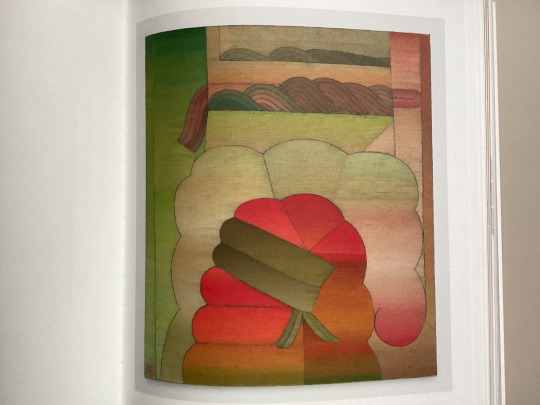
“I have no place to take myself except painting.” – Miyoko Ito, 1978.
Miyoko Ito (1918–1983) was a Japanese American painter, born in Berkeley, California, and was active in Chicago where she studied at the Art Institute of Chicago.
When the World War II began in 1941 in the United States with the attack on Pearl Harbor, Ito was studying art at University of California, Berkeley. She was a senior scheduled to graduate in May 1942. In April 1942, Ito married Harry Ichiyasu to avoid being separated during the wartime incarceration of Japanese Americans. Her husband was president of the senior class of the Japanese constituency at UC Berkeley. They were married on April 11th, but by the end of April they were sent to Tanforan internment camp near San Francisco, and later sent to Topaz under an Executive Order signed by Franklin D. Roosevelt. Ito received her diploma while she was in the internment camp, then received a grant to attend a graduate program at Smith College. She stayed there for one year before going on to study at the Art Institute of Chicago. Ito said she cried when she opened her diploma. She graduated with highest honors.
Miyoko Ito was hardly unknown during her lifetime, though she gained some attention and was granted residency fellowships at MacDowell in New Hampshire. It was there that she experienced “the meaning of full expression in the conductive environment,” she wrote in her “Plan of Work” in 1983. She continued, “I would like to escape the heretofore stifling condition of low ceiling, dim daylight, and inadequate floor space” of her bedroom studio in her house.
This publication, “Miyoko Ito: Heart of Hearts” is the first book dedicated to the life and work of Miyoko Ito, long overdue for this artist.
Image 1: Front cover featuring “Island in the Sun”, 1978, Oil on canvas, 38”x 33”
Image 2: Portrait of Miyoko Ito by Mary Baber, 1975
Image 3: “Aura”, 1966, Oil on canvas, 50”x 45”
Miyoko Ito : heart of hearts Pre-Echo, 2023. 452 pages : illustrations (chiefly color), portraits ; 30 cm English HOLLIS number: 99157645381703941
#AANHPIHeritageMonth#AsianAmericanNativeHawaiianPacificIslanders#AsianAmericanArtists#JapaneseAmerican#JapaneseAmericanArtist#JapaneseAmericanWomenArtist#WomenArtist#MiyokoIto#HarvardFineArtsLibrary#Fineartslibrary#Harvard#HarvardLibrary#AbstractPainting
22 notes
·
View notes
Text

Alice Baber in her studio, 1972. Photo by Richard Galef.
Alice Baber (August 22, 1928 – October 2, 1982) was an American abstract expressionist painter who worked in oil and watercolor. She was educated in the United States and in the 1950s and 1960s she studied and lived in Paris. She also traveled around the world. Baber, a feminist, organized exhibits of women artists' work. Via Wikipedia
#Alice Baber#in her studio#art by women#art#palianshow#women's art#art herstory#abstract expressionist
4 notes
·
View notes
Text
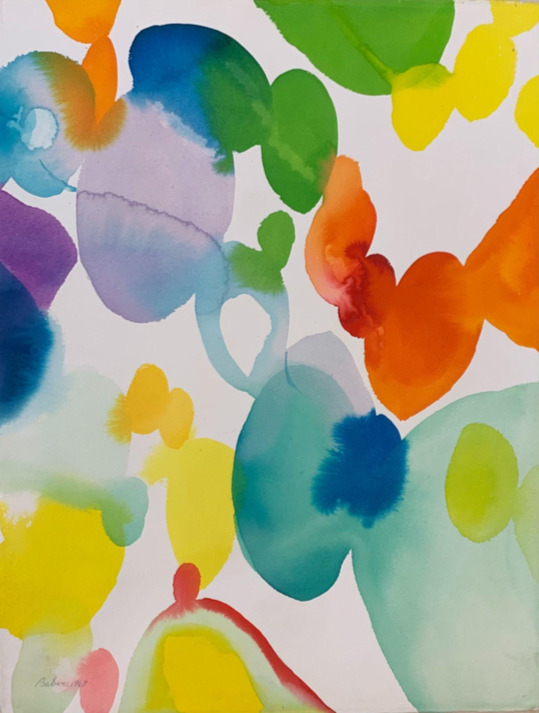
Alice Baber (United States, 1928-1982), Green Journey, Watercolor, 1969.
Gift of Alice Baber. Art, Design & Architecture Museum; UC Santa Barbara.
#alice baber#watercolor#art#1969#Abstract Expressionism#painting#american#american painter#Green Journey#american artist#american art#baber#expressionist
25 notes
·
View notes
Text
The study of geography had long been used to bolster national pride and imperialist agendas of European countries and the United States. During Baber’s time, says geographer Janice Monk, who co-wrote an extensive 2015 biographical profile of Baber, “Many geographers believed that environment determined culture and cultural accomplishments, and geographers and the general public believed that Western culture was the epitome of cultural achievement.” These beliefs, in turn, justified white Western occupation of places that were seen as “less civilized” through the lens a Eurocentric worldview—a worldview that Baber would come to challenge.
. . .
Baber’s approach to education was holistic: for her, what seemed like disparate branches of knowledge were, in fact, interdependent and should be taught as such starting in elementary school. “The understanding of geographic facts necessitates a knowledge of science, mathematics, and history, and demands expression in reading, writing, modeling, drawing, painting, and making,” she wrote in the journal Elementary School Teacher. Baber believed that three main pedagogical elements could accomplish this interdisciplinary education, which she laid out in a 1904 article “The Scope of Geography.”
. . .
In an article in The Course of Study (now The Elementary School Journal), co-authored with Wallace W. Atwood, Baber encourages teachers to integrate international correspondence with students of foreign countries into the geography classroom. A woman openly critiquing imperialism in the pages of a professional journal was not a common occurrence.
Yet in the article, Baber articulated how European colonizers took the geography and advanced cartography of indigenous people and used the information they provided to colonize them. In the case of the Peruvians, she wrote, “[t]hey possessed relief and political maps of their country which were of great value to their destroyers.”
These progressive attitudes would also color her work outside of education. In 1925, as chairman of the Pan-American committee for the Women’s International League for Peace and Freedom, she helped investigate the conditions in Haiti under U.S. military occupation at the request of Haitians, and co-authored a report calling for the complete end of US military presence in the country.
A year later, she represented the women of Puerto Rico in the expansion of suffrage to the territory. She was elected a member of the Society of Women Geographers in 1927, and in 1948, was awarded the Gold Medal for lifetime achievement by the organization she founded 40 years before, the Chicago Geographic Society.
3 notes
·
View notes
Text

Captain Alonzo C. Babers (October 31, 1961) is a former athlete, winner of two gold medals at the 1984 Summer Olympics, in the 400 m and the 4 × 400 m relay.
Born in Montgomery, Alabama, he was a military dependent who graduated from Kaiserslautern American High School in West Germany. He attended the United States Air Force Academy (1979-83) graduating with a major in aerospace engineering, where he ran track and played one season of football.
His career consisted of a spectacular rise to fame, followed by a decisive and abrupt end. Up to the end of 1982, Babers’s best time in 400 m was 45.9, but he rapidly improved on that during 1983, running a best time of 45.07, at the 1983 World Championships in Helsinki he finished in a disappointing sixth place in the 4 × 400 m relay.
He continued his rapid improvement in 1984. At the USA Final Olympic Trials in Los Angeles, he won his semi-final with a personal best of 44.95. In the final, he ran another personal best of 44.86 to qualify for the Olympic team. At the Los Angeles Olympic Games, he further lowered his personal best to 44.75 when he won his quarterfinal. In the Olympic final, Babers ran 44.27 to win the gold medal. In the 4 × 400 m relay, the US (he ran the third leg) won the gold medal easily in 2:57.91.
While training for and competing in the 1984 Olympics, he held the rank of lieutenant in the Air Force. Just one month after his double-gold performance in Los Angeles, he reported to flight training school and began his career as a pilot, so his athletics career was over. He was an active-duty officer in the Air Force (1983-91) and continues to serve as a member of the Air Force Reserves. He became a Boeing 777 captain for United Airlines. #africanhistory365 #africanexcellence
1 note
·
View note
Text

youtube
Sharing these comics doesn't constitute an endorsement, but they are shared here for you to reflect upon. They're a ⬆️ MUST READ, because these strips lay out important questions that need answers.
Charlie Baber is the 🌈🥜 "Peanuts" (popularity stature) cartoonist of ⛪ same-sex United Methodist churches.
At the end of Part 1 is a LINK to Part 2, through to the end.

youtube
Yesterday at our Church, 📚 Psalm 133 and Monty Python were referenced.
Self-determination is a topic gaining momentum, and will NOT soon go away.
🕎✝️🙏 Father God, help 🌉 bridge the divides. Teach us to be even BETTER listeners.

There may soon come a time when you'll lose rights to 🆓 speech 💬. THIS ⬆️ could be the debut of weaponization.
Children of God hold MANY Theological interpretations, but we share a common 👿 enemy. SEEK 🫂 common ground.

MUST 🇨🇳 WATCH‼️
Who will speak for you, on a global 🌎 stage? As of NOW, 🇺🇸 we have no head of State.

youtube
MUST 👁️👁️ SEE❣️
Interview that aired Sunday, April 23, showing a better list of accomplishments, 🆚💤 sleepwalker-mafioso joey.

youtube
Where does the buck STOP?


youtube
White "House of cards" WILL FALL. Truth 🕎 shall prevail.
0 notes
Photo

Alex Baber
Bramble Cottage
Great Livermere, United Kingdom
Free to use under the Unsplash License
Tea is at four
21 notes
·
View notes
Text

Having visited Pakistan and China, is Argentina ready to buy the JF-17 jet?
Fernando Valduga By Fernando Valduga 06/26/2022 - 1:51 PM in Military
Pakistani Air Force JF-17 jets. (Photo: www.PAFwallpapers.com)
The recent visit to Pakistan by the head of Argentina's Joint Chiefs of Staff fueled speculation that a JF-17 fighter agreement is on the horizon after more than a decade of interest from the South American nation. But despite China's willingness to help finance an acquisition program, it is not clear if there has been any important progress.
Lieutenant General Juan Martín Paleo visited several military personnel and government figures from June 14 to 15 in Islamabad, including the head of the Pakistan Air Force, Marshal Zaheer Ahmed Baber Sidhu, and the Minister of Defense Production, Muhammad Israr Tareen.
Although Paleo is the senior military officer of Argentina, he is not the main decision maker in the selection of a new fighter. This role belongs to General Xavier Isaac, head of the Argentine Air Force.
In May, a delegation of pilots and technicians from the Argentine Air Force evaluated the JF-17 in China. This included a complete technical evaluation, use of a simulator and evaluation flights. On the most recent trip to Pakistan, the authorities discussed collaboration in the production of defense material during a visit to the Ministry of Defense Production.
Neither the ministry, the Defense Export Promotion Organization nor the local Argentine Embassy responded to requests for additional information.
However, sources in Argentina said that authorities discussed the possibility of having the FC-1 - the export variant of the JF-17 - assembled in the country, with parts and components supplied by China and Pakistan, as well as some produced locally. The country would eventually like to be able to make major modifications to its own FC-1 aircraft, military officials and government officials said, speaking on condition of anonymity because of employment security concerns.

Export version of the JF-17, the FC-1.
Andrei Serbin Pont, who leads the Argentine think tank CRIES and was a consultant to the country's Secretariat of Strategic Affairs, is not convinced that Paleo's trip implies that an agreement for the JF-17 Thunder is imminent.
“In my experience, nothing in the Argentine defense sector is defined until the contracts are signed and Argentina really starts paying,” he said, especially since the country's current economic crisis is “quite deep, with dangerously low reserves and possibilities of default.”
It is also unlikely that the government will make large investments in defense without any political benefit. There is one year left until the elections, which is not enough time for the ruling party to "harvest the political capital obtained from any successful military purchase".
The government's preference to balance suppliers by nationality can also hinder efforts to acquire the JF-17, as it prefers to "express a certain degree of equidistance with China and the United States, hoping not to harm the relationship," explained Serbin Pont.
The Argentine Army is currently considering an armored eight-wheel drive combat vehicle from China North Industries Group Corporation Limited, also known as NORINCO. If selected, "this will probably reduce the chances of the Chinese Air Force to go to the JF-17 and vice versa," he said.
Why choose the JF-17?
Since retiring its last Mirage aircraft in 2015, the Argentine Air Force has not had high-performance supersonic interceptors. Its current operational inventory includes at least 10 A-4 fighter-bombers, which are complemented by armed IA-63 Pampa jet trainers.
In September 2021, the Argentine Ministry of Defense allocated US$ 664 million for the acquisition of 12 fighter jets, having received offers from Russia for the MiG-29 and MiG-35 Fulcrum, as well as from China and Pakistan for the JF-17, according to the International Institute of Strategic Studies. "Plans to acquire aircraft from other sources have failed in recent years, supposedly as a result of pressure from the United Kingdom," wrote the London-based think tank in its latest report "Military Balance".
It is likely that Argentina is specifically considering the JF-17 Block III variant, which is currently in production for Pakistan, said Richard Fisher, a senior member of the U.S.-based think tank International Assessment and Strategy Center.
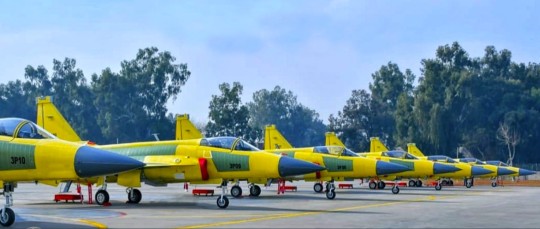
Lot of JF-17 Block III fighter jets.
Block III has an electronically digitized active radar, as well as advanced weaponry, such as the PL-15 long-range air-to-air missile and anti-ship supersonic missiles. Consequently, Fisher said, the variant would be “the most competitive against the British F-35B and Typhoon fighters,” and Western and Russian subsystems and components could be easily exchanged for Chinese versions, potentially neutralizing the threat of sanctions.
"Argentina seems to be looking for the best capacity with the lowest spending," he said, and this "is a good omen for the JF-17."
The aircraft is facing a Danish offer of a dozen surplus F-16A/B MLU fighters.
Based on statements by several Argentine military and government officials, there is interest in basing future interceptor jets in Rio Grande, in the province of Tierra del Fuego, to defend the extreme south of the country. Other possibilities include Tandil in the province of Buenos Aires, Reconquista in the province of Santa Fe and Villa Reynolds in the province of San Luis.
Asked if the aircraft would meet the operational requirements, Serbin Pont said that the Argentine Air Force is effectively out of options. “Therefore, the JF-17, even with limitations compared to other generation 4 and 4+ fighters on the market, would be an upgrade to [Argentina Air Force].”
Assembly and financing
Fisher noted Argentina's hopes of producing the JF-17 locally and wondered "if Pakistan would approve and contribute to a competitive Argentine co-production capacity," as the South American country wants to become "a regional supplier of combat aircraft, with the JF-17 as its main product."
Currently, the Pakistan Aeronautical Complex has a 58% stake in the JF-17 program, which means that even aircraft exported to Myanmar by Chinese partner Chengdu Aircraft Corp. were partially manufactured in Pakistan, with final assembly by the corporation.
Although the Pakistani complex lost work due to Argentine production, it would still receive royalties. And the local assembly would still see the aeronautical specialist make the same percentage of each aircraft before the parts are sent to Argentina.
The final assembly of the aircraft and the production of parts could take place at the Argentine "Brigadeiro San Martín" Aircraft Factory (FAdeA) in Córdoba, but the work would probably involve other subcontractors scattered throughout the country. An engine and subcomponent maintenance center could be installed in the Río Cuarto Material Area of the Air Force, also in Córdoba.
It is also possible that the program will involve INVAP, a company based in Bariloche, in the Patagonia region, specialized in the development of radars and optronics, with the ability to develop national systems or adapt foreign systems for aircraft integration.
Fisher said that Pakistan "refused" Argentina's co-production plans a decade ago, but that Paleo's visit "is a strong indication that a future Argentine acquisition of the JF-17 will be made with full cooperation from Pakistan and inclusion in possible co-production agreements."

In addition, China-backed local assembly and production “would add political incentive to Uruguay, Peru, Ecuador, Bolivia, Venezuela and perhaps Cuba to consider this low-cost fighter,” he added.
Fisher believes that this would help China's regional ambitions, noting that China offered Argentina the most capable F-10C Firebird "around 2014 to 2015". However, "it seems like it was very expensive," he noted.
This is unlikely to be a problem for the more affordable JF-17, since Chinese "very dealer" financing of "all major weapons purchases" will be available, he added.
Military sources said that China has offered a government loan to government for an eventual order for the jet and is willing to accept partial payment on beef and other commodities produced by Argentina.
"If China wants to break down the strategic balance in Latin America with the anxious help of Argentina and others who will fight with it, China will have to subsidize the purchase of weapons to start these events," Fisher said.
Source: DefenseNews
Tags: Military AviationCAC/PAC JF-17 ThunderFAA - Fuerza Aerea Argentina/Argentinian Air Force
Previous news
U.S. Poseidon aircraft flies over Taiwan Strait to contain China's military expansion, analysts say
Next news
Record altitude in helicopters reaches 50 years old
Fernando Valduga
Fernando Valduga
Aviation photographer and pilot since 1992, he has participated in several events and air operations, such as Cruzex, AirVenture, Dayton Airshow and FIDAE. He has works published in a specialized aviation magazine in Brazil and abroad. He uses Canon equipment during his photographic work in the world of aviation.
Related news
MILITARY
U.S. Poseidon aircraft flies over Taiwan Strait to contain China's military expansion, analysts say
06/26/2022 - 12:04 PM
Two Turkish Air Force A400 transport aircraft have been detained in Ukraine for four months. (Photo: Turkish Ministry of National Defense)
MILITARY
Two Turkish A400s have been detained in Ukraine since the Russian invasion
06/25/2022 - 6:00 PM
A LANCA crewless "loyal wing" operating with an RAF F-35B. (Photo: UK Ministry of Defense)
MILITARY
United Kingdom cancels demonstrator program "loyal wing" Mosquito
06/25/2022 - 4:00 PM
Chinese Army Z-20 helicopters, a possible copy of the U.S. Black Hawk.
MILITARY
Former U.S. military pilot admits to selling aviation information to China
06/25/2022 - 3:10 PM
MILITARY
Netherlands confirms purchase of 6 more F-35 fighters and 4 Reapers
06/25/2022 - 12:38 PM
MILITARY
Russian jets are flying so low to avoid the Ukrainian air defenses that are colliding with the ground
06/25/2022 - 10:48 AM
HOME Main Page Editorials Information Events Collaborate SPECIALS Advertise About
Cavok Brasil - Digital Tchê Web Creation
Commercial
Executive
Helicopters
History
Military
Brazilian Air Force
Space
SPECIALS
Cavok Brasil - Digital Tchê Web Creation
2 notes
·
View notes
Text
https://thepurewood.com/en-in/the-classic-line/
Our range of classic Baber units & Beauty Salon Furniture Interior units is perfect for your next location.
We have a wide range of classic Baber units & Beauty Salon Furniture Interior units. Purewood also provides you with the best Barber Furniture Online.
We offer a wide range of classic Baber units & Beauty Salon Furniture Interior units. Purewood also provides you with the best Barber Furniture Online.
We strive to provide you with the best service and quality products. We take pride in our products, and we are always working hard to improve on them.
0 notes
Text
OTTAWA — Rookie Ontario MP Leslyn Lewis is taking a second run at the Conservative leadership.
She confirmed her candidacy in a 45-second video shared on social media Tuesday and emailed supporters asking for help to collect the 500 signatures she needs to officially enter the race. She also launched her campaign website with a link to purchase memberships to support her and make donations.
"I'm running to lead our party and our country based on hope, unity and compassion," Lewis wrote on Twitter.
She is the second declared candidate in the race. Ottawa-area MP Pierre Poilievre, announced his candidacy last month just days after Erin O'Toole was voted out of the leadership by the Conservative caucus after just 17 months in the role.
Former Quebec premier Jean Charest has scheduled a campaign launch event in Calgary Thursday, where he will formally announce his candidacy.
Several others are still mulling it over, including former Conservative MP Patrick Brown, now the mayor of Brampton, Ont., former Ontario MP Leona Alleslev, current Ontario MP Scott Aitchison and independent Ontario MPP Roman Baber.
Lewis, a former Bay Street lawyer who moved to Canada as a child from Jamaica, ran in the 2020 leadership contest as a relative unknown, having never before served in elected office. She was the only woman in the race and placed third behind O'Toole and Peter MacKay, a former Tory cabinet minister who led the Progressive Conservative party before it merged with the Canadian Alliance in 2003.
She has been a vocal critic of COVID-19 vaccine mandates and a Liberal campaign promise to revoke the charitable status of anti-abortion pregnancy centres.
She pulled a lot of support from the party's base in Western Canada and members of its well-mobilized social conservative network, some of whom are already backing her again.
"I can say with confidence we will 100 per cent be endorsing Leslyn Lewis in the upcoming Conservative Party leadership race," said Alissa Golob, co-founder of the anti-abortion political group RightNow.
"Lewis is currently the only candidate who can truly unite the party and win the demographics the party needs to target to win."
Lewis was elected as an MP just last fall in the rural southwestern Ontario riding of Haldimand-Norfolk but was not given a role in O'Toole's shadow cabinet.
That omission drew the ire of the party's social conservative wing, many of whom moved their votes from Lewis to O'Toole in the 2020 leadership's final ballot, helping him secure the victory.
This lady seems cool
1 note
·
View note
Link

#dark harvest#paul moore#don digiulio#jeanie cheek#jennifer leigh#scarecrow#monster#monsters#creature#creatures#slasher#supernatural#b.w. york#comedy#united states#jessica dunphy#paul bugelski#j.p. linkous#ralph baber#bootie chewning#horror#horror film#horror films#horror movie#horror movies#horror fan#horror fans#horror review#horror reviews#horror reviewer
0 notes
Text

Happy BornDay John Gibbs St. Clair Drake
John Gibbs St. Clair Drake was a pioneering black social anthropologist and activist, one of only nine black anthropologists before WWII. He dedicated his scholarship – ethnographic studies of race, class, and social structure – to the eradication of social inequalities and racial injustice.
Born in Suffolk, Virginia in 1911, Drake attended the black Hampton Institute, and then Pendle Hill, a Quaker graduate school outside Philadelphia. In 1935, Allison Davis, a teacher from Hampton, asked Drake to assist with anthropological research in Natchez, Mississippi on a project called Deep South. Drake began two years of fieldwork with the town’s lower class sharecroppers and factory workers. With the urging of Davis and W. Lloyd Warner, he applied for a Rosenwald Fellowship to attend the University of Chicago and began formal training in anthropology. His PhD was awarded in 1954.
Drake was an activist anthropologist. He was initially drawn to Anthropology because he believed it could “aid in dissipating stereotypes about black people and in eliminating errors based on confusion between biological and environmental factors in accounting for observed racial differences,” [1] as he explained in a 1988 interview with George Clement Bond. While at the U of C, he began pioneering fieldwork in Chicago on migration, race, class, and community. The work was published with sociologist Horace Cayton as Black Metropolis (1945) – a groundbreaking, landmark work in the anthropology of race and urban anthropology.
After dissertation fieldwork in Tiger Bay, Cardiff, Drake’s political and intellectual interests shifted to Pan-Africanism, and the potential of newly independent African nations. He moved to West Africa, where he taught at the University of Liberia and the University of Ghana, and did ethnographic research in Ghana until 1966. During this time (1946-1968), Drake also developed and administered one of the first African Studies programs, at Roosevelt College in Chicago. In 1969, he took a position at Stanford University as the head of Black Studies. Drake remained at Stanford until his retirement in 1976. He died in 1990.
For Drake, generalized social theory was useful for analysis, but his primary concern was with the applied, activist relevance of his ethnographic research. Bringing the tools of anthropology to social activism – uniting theory and praxis – has been one of Drake’s most enduring contributions to a politically-engaged anthropology. Drake many publications and ethnographic research on race, class, status, and political economy in the US South, Chicago’s Southside, Tiger Bay and Ghana pioneered anthropological analysis of the African Diaspora and the development of African-American Studies. He fought against racism and injustice throughout his career: he participated in a student strike at Hampton against white domination; he was active in a fight against urban renewal in Hyde Park while a student at Chicago; he was an active member of CORE, NAACP, SNCC, and the National Negro Congress, among other political groups; he advised Kwame Nkrumah, the first Prime Minister of Ghana; and he trained Peace Corps volunteers to Ghana.
It was not until his tenure at Stanford University, late in his career, that St. Clair Drake was first given the chance to train graduate students in anthropology. He worked closely with Faye Harrison (U Florida), Willie Baber (U Florida), Edmund “Ted” Gordon (U Texas-Austin), and Glen Jordan (U Glamorgan, Wales UK). Before that he influenced the lives and studies of many undergraduate students and Roosevelt University, including the late Vera Green (Rutgers)...
39 notes
·
View notes
Text
2019 ACC Coaching Power Rankings

During the offseason I like to do some of these fun projects that I normally wouldn’t have time to write while football is actually getting played. One of my favorites is the Coaching Power Rankings, where I decide where each coach rates relative to his peers.
The ACC was probably the worst Power 5 conference out there last year, but the coaching seems fairly strong. I think we’ll be seeing a lot of good football coming out of the conference very soon as so many programs develop.
The ACC lost four coaches last season, the highest among the Power 5, including some of the best in the league. The venerable Paul Johnson (last year’s #4 coach in the conference) and Mark Richt (#2) retired at the end of the year. Bobby Petrino (#5) was fired after Louisville completely collapsed after years of strong play. Similarly, Larry Fedora (#7) was canned when North Carolina’s rebuild kept spinning its wheels.
That means the ACC lost four coaches in the top half of its ranks. That’s pretty tough to overcome, at least immediately. However, the league has made some good hires which should help get all four programs back on track, though it may take a while.
Oh yeah, and since he has to go somewhere, Brian Kelly is being counted as an ACC coach for the purposes of this list.
Check out the list from last year to compare and contrast by clicking this link.
-

15. Manny Diaz
Record Overall: N/A
Movement: N/A
Manny Diaz is the only first time head coach in the conference, so he has to start all the way at the bottom. Diaz has been a talented DC everywhere he’s coached. Under Mark Richt, Diaz fielded one of the best defensive units in the conference. We’ll see how fast Diaz can get the Hurricanes back to their winning ways, but in 2019 that turnaround will have much more to do with the offense.
-

14. Geoff Collins
Overall Record: 15-10
Movement: N/A
Geoff Collins has the monumental task of de-converting a triple option team back into a “regular” football offense. So Georgia Tech is probably gonna suck this year as personnel gets moved all around and the offense entirely reworked. However, there’s good reason to be optimistic about Collins. In his two years as Temple’s head coach, Collins kept up the Owls’ run as the plucky yet steady winner in the AAC. If he can bring Tech into the modern era and make them the University of Atlanta like he seems to be trying to do, he could do a whole lot of winning. Eventually.
-
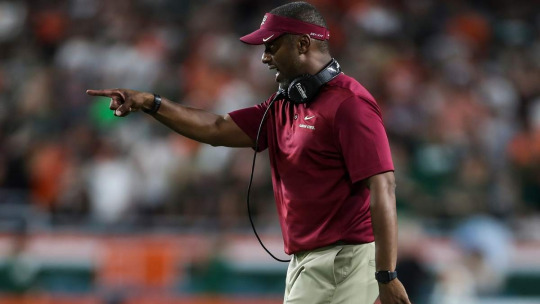
13. Willie Taggart
Record at Virginia: 5-7 Overall Record: 52-57
Movement: Up 2 spots
More or less by default, Willie Taggart moves up two spots to make room for two of the four new coaches to the ACC. His first year was not exactly a smashing success. It was Florida State’s first losing season since 1976, so people were pretty upset. I mean, it wasn’t totally his fault. He inherited a team that somehow didn’t have offensive line personnel, that he won 5 games is an accomplishment.
I have faith in Taggart, he built Western Kentucky into a competitive FBS program, he totally rebuilt a South Florida team that was in shambles, and in one season he returned Oregon to the ranks of the respectable. All things considered I think he has the potential to reawaken FSU and challenge Clemson. But that’s a ways away, and he better start winning this year.
-

12. Steve Addazio
Record at Boston College: 38-38 Overall Record: 51-49
Movement: Up 2 spots
For a couple weeks in the middle of last season, it was looking like Boston College might be turning the corner. The Eagles were 7-2 and ranked for the first time in a decade. Then they lost to Clemson, FSU, and Syracuse and their bowl game against Boise State was literally rained out. So, BC ended the year with 7 wins for the fifth time in Steve Addazio’s six seasons on Chestnut Hill. I give Addazio a lot of credit for getting the FBS’s furthest Northeast outpost back to being a competitive team year in and year out. It’s not a bad place to be, but they just can’t seem to take that next step and climb into the top third of the ACC standings. I hope he does it, but it might take a coach with more talent than my dude Steve Addazio.
-

11. Scott Satterfield
Overall Record: 51-24
Movement: N/A
Scott Satterfield leaps in higher than the other newbie coaches because, I mean, did you see what he did at Appalachian State? Well, you probably didn’t, at least not on TV or in person. The Mountaineers have been one of the best G5 teams in the country for the past four years. App State won the Sun Belt for the past three seasons and were the winner of the inaugural Sun Belt Conference Championship Game in 2018. I’m sure he’s gonna do a great job at Louisville, though like Collins in Atlanta, this might take a bit of time.
-
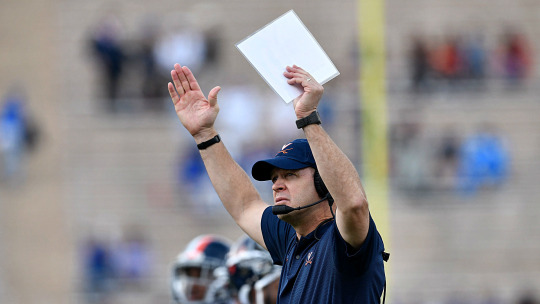
10. Bronco Mendenhall
Record at Virginia: 14-22 Overall Record: 115-65
Movement: Up 3 spots
The Virginia rebuild took a big step in 2018, as the Cavaliers nearly won the ACC Coastal in Bronco Mendenhall’s third season at the helm. I expect that they’ll keep improving, in fits and starts perhaps, but Mendenhall is a great coach and he’s done a wonderful job so far. I expect he’ll be climbing this list as long as he’s in Charlottesville. Adjusted more heavily for difficulty, he should be even higher up this list.
-
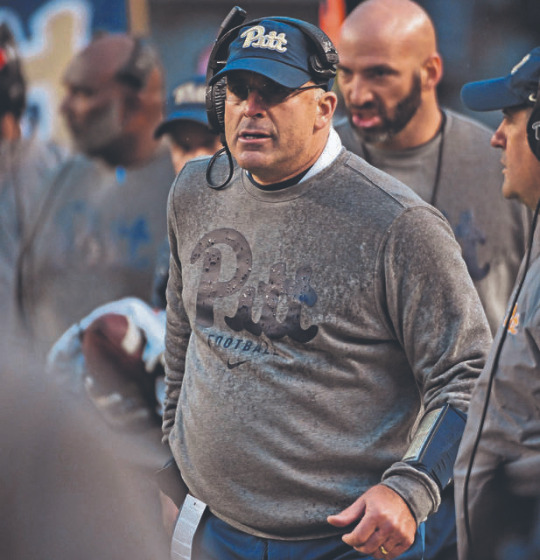
9. Pat Narduzzi
Record at Pittsburgh: 28-24 Division Championships: 1 (2018)
Movement: Up 3 spots
Pat Narduzzi won Pittsburgh’s first division title in the ACC last season despite a 7-5 record. It’s still pretty good accomplishment, especially considering that the Panthers probably weren’t the best team in the Coastal. They got hot at the right time and sometimes that’s enough. We’ll see if Narduzzi follows Addazio in the perpetually mediocre basket, but he’s off to a better start and he’s in the right division.
-
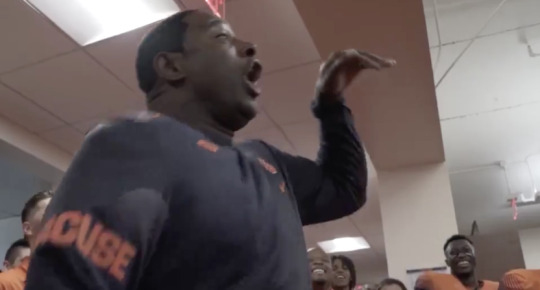
8. Dino Babers
Record at Syracuse: 18-19 Overall Record: 55-35
Movement: Up 3 spots
Narduzzi’s counterpart in the Atlantic Division had an even better year. Dino Babers’s Syracuse Orange exploded to their first 10 win season since 2001. From Eastern Illinois to Bowling Green to ‘Cuse, Babers has won everywhere he’s coached. He’s not in the right division to really compete for a conference crown, but with Florida State and Louisville out of commission, let’s see what Babers can build so long as he’s not offered gobs of money to take his considerable talents somewhere warmer.
-

7. Justin Fuente
Record at Virginia Tech: 25-15 Overall Record: 51-38 Division Championships: 1 (2016)
Movement: Up 2 spots
I have to say, I’m a bit disappointed in Justin Fuente. His first season went over so well I assumed he’d have the Hokies almost back to Beamer-esque levels by now. Perhaps that’s a bit optimistic, but 2018 was a nightmare season for the Hokies in terms of sheer attrition, very few teams lose that many guys, so I can give him a pass here. Still, expectations are high, I’m sure Fuente can win 10 games again, but it’s not like he’s got all the time in the world to do so. He’s entering his fourth year after all.
-
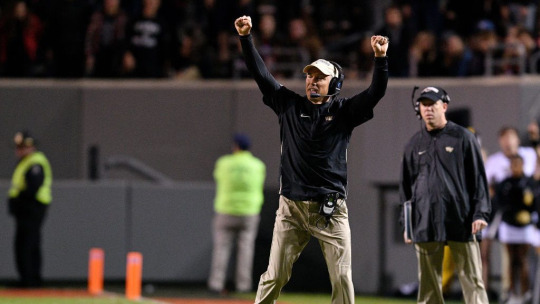
6. Dave Clawson
Record at Wake Forest: 28-35 Overall Record: 118-115
Movement: Up 4 spots
Applause all around for Dave Clawson. Wake Forest lives one of the more desolate existences for a P5 program and Clawson has had the Demon Deacons bowling for the past three seasons. His predecessor, and best Wake coach in living memory, Jim Grobe only managed that feat once. I’m very interested to see how high the Deacs can rise, but I’m worried Clawson also might get poached before Wake Forest reaches their full potential. I’m honestly surprised he hasn’t gotten more attention, he’s perhaps the best turnaround artist in the game right now.
-

5. Dave Doeren
Record at NC State: 43-34 Overall Record: 66-38
Movement: Up 3 spots
Welcome to the top 5, Dave Doeren! NC State has been one of the top programs in the ACC in the past two years and the Wolfpack are eager to see how far they can go under Doeren. It’s really hard to see them competing at Clemson’s level, but everything after that is up for grabs, especially with FSU, Miami, VA Tech, GA Tech, and Louisville all struggling.
-

4. David Cutcliffe
Record at Duke: 67-72 Overall Record: 111-101 Division Championships: 1 (2013)
Movement: Up 2 spots
The beloved professor emeritus of the ACC, David Cutcliffe gets a nice bump up the rankings to the top five, where he truly belongs. Cutcliffe has turned the Blue Devils into one of the most consistent winners in the ACC in the 2010′s, which is just a stunning accomplishment considering Duke football’s usual lot in life. He really is a cut above.
-

3. Mack Brown
Record at North Carolina: 69-46-1 Record Overall: 244-122-1 National Championships: 1 (2005)*
*with Texas
Movement: N/A
Oh man, Mack Brown is back in college football. Brown was one of the best coaches a generation or so ago, so it’ll be very interesting to see what he can do at North Carolina...again. Brown, of course, was already the head coach of the Tar Heels for a whole decade, from 1988 to 1997, before heading off to Texas where he reached the apex of his career. Back in the day, Brown had UNC running like a well-oiled machine. If Bobby Bowden’s Florida State wasn’t pushing everybody around, North Carolina would have won several ACC championships. He got back to back top ten end of year rankings at UNC, that just doesn’t happen.
Of course, that was over 20 years ago. Old coaches usually don’t do as well when coming back out of retirement like this, but Brown will probably do a lot to re-energize the fan base, bring in big recruits, and get newer facilities built. That’ll go a very long way in the Coastal Division.
-
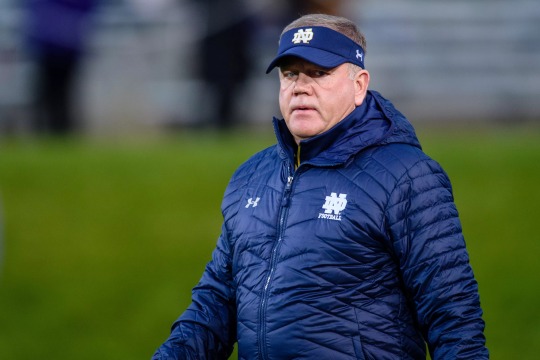
2. Brian Kelly
Record at Notre Dame: 81-35 Overall Record: 252-92-2
Movement: Up 1 spot
Notre Dame’s not very lovable hardass crashes the ACC party all the way up at #2 on the list. It’s kind of hard to remember how bad Notre Dame used to be before Kelly came into town, they were pretty pathetic for all of the 2000′s, which is kinda crazy because the Fighting Irish are one of the most successful programs in the history of the sport. It’s hard to remember because Kelly has done such a good job building ND back into a powerhouse. They’re still one step or so removed from being real National Championship caliber, but hey, that’s a short list. Notre Dame, of course, went 12-0 last year, their second undefeated regular season under Kelly, and they’ll probably pick up right back where they left off. The only loss the Irish suffered last year...was to our Mr. #1.
-

1. Dabo Swinney
Record at Clemson: 116-30 Division Championships: 7 (2009, 2011, 2012, 2015, 2016, 2017, 2018) Conference Championships: 5 (2011, 2015, 2016, 2017, 2018) National Championships: 2 (2016, 2018)
Movement: Same
Dabo Swinney had a pretty good 2018. He put together his best season yet, a 15-0 campaign that looked absolutely effortless for large swathes of the year. Do you know how good of a job you have to be doing to have people think that you’re outdoing Nick Saban? It’s incredible, honestly. Dabo Swinney, ten years into his career, might already be the best coach ever in the history of the ACC. Bobby Bowden is the only man with a better resume, but he spent some of his best years outside of the conference. And Swinney could coach another 20 years. My God.
-
Lastly, a fond farewell to my favorite image since starting this blog:

Happy trails, Paul Johnson.
#college football#Clemson Tigers#Notre Dame Fighting Irish#North Carolina Tar Heels#Duke Blue Devils#NC State Wolfpack#Wake Forest Demon Deacons#Virginia Tech Hokies#Syracuse Orange#Pittsburgh Panthers#Virginia Cavaliers#Louisville Cardinals#Boston College Eagles#Florida State Seminoles#Georgia Tech Yellow Jackets#Miami Hurricanes
2 notes
·
View notes
Text
Adam Warner Flexes His Classic Country Muscle On Rousing & Rockin’ Remake Of Charlie Daniels

Country singer-songwriter and U.S. Marine veteran Adam Warner grew up on his family’s farm in Southern Illinois near Lawrenceville listening to a lot of Charlie Daniels. So much so that he credits the late country legend as one of his biggest musical inspirations for growing into the experienced Nashville-based country recording artist he is today. To commemorate the life and musical legacy of Daniels, Warner has released his own upbeat and fresh-take rockin’ and rousing rendition of Daniels’ iconic song, “Long Haired Country Boy,” available everywhere July 5 on Sunday Supper Records and The Orchard , and the 11th track on his forthcoming new album, What We’re Known For. The song’s accompanying music video was exclusively premiered in a recent feature at People.com by renowned country music journalist Tricia Despres. Warner and his team shot the video at Capricorn Studios in Macon, Georgia, the original studio where Daniels cut “Long Haired Country Boy” on his 1974 album Fire On The Mountain. “Charlie has always been a hero of mine,” Adam explained. “And one of the coolest things about music is it’s timeless, and lives on long after we’re gone. So I wanted to do my part to keep Charlie’s musical legacy living forever!” Adam will also donate a portion of the proceeds raised from the track to The Charlie Daniels Journey Home Project, a not for-profit organization that assists other not-for-profits in securing funds to help causes that benefit veterans of the United States Armed Forces. “I’m blessed and honored to support the Charlie Daniels Journey Home Project through this recording of Charlie’s classic song,” Adam said. “So take a listen, and help support a veteran!” What We’re Known For is the follow-up album to Big Storm (2021), which contained fan favorites “4 Square Miles,” “That’s How You Know You’re Livin’” and “SemperFi” featuring Trace Adkins. The album was exclusively premiered by American Songwriter Magazine. Single name: “Long Haired Country Boy” Release date: July 5, 2022 Stream/Buy/Listen: orcd.co/yeogrvk Songwriters: Charlie Daniels ISRC#: QM4TX2231783 Album name: What We’re Known For Record label: Sunday Supper Records / The Orchard Audio produced by: Daniel Dennis Video director: Karl Weidmann, Josh Mendez with Southern Cabin Films Official video: youtu.be/4PryzKygIH4 What We’re Known For Track Listing & Songwriters: - What We’re Known For (Mark Addison Chandler, Matt Williams) - Catchin’ Hell (Adam Warner, Mark Addison Chandler, Davis Corley, Josh Gallagher) - Lost In A Country Song (Barrett Baber, John Caldwell, Mark Addison Chandler, Taylor Goyette) - Split A Beer (Adam Warner, Mark Addison Chandler, Josh Gallagher, Taylor Goyette) - One Drunk (John Caldwell, Mark Addison Chandler, Davis Corley) - Reason To Redneck (John Caldwell, Mark Addison Chandler, Davis Corley, Dawson Edwards) - Got Started (Adam Warner, Mark Addison Chandler, Lewis Brice, Josh Gallagher) - Like Daddy Did (Adam Warner, Smith Curry, Steven Nix) - First Face (Adam Warner, Mark Addison Chandler, Lewis Brice, Josh Gallagher) - Granny’s Lincoln (Adam Warner, Mark Addison Chandler, Davis Corley, Josh Gallagher) - Long Haired Country Boy (Charlie Daniels) - Goodbye Hometown (Trafton Harvey, Quinn Loggins, Joe Doyle) 2022 Show Dates: JUL 22 – Lori’s Roadhouse / West Chester, Oh. JULY 23 – Spillway Bar & Grill / Bowling Green, Ky. JUL 29 – Bristol Republic / Columbus, Oh. JUL 30 – Bristol Republic / Columbus, Oh. AUG 19 – Stoney’s Rockin’ Country / Las Vegas, Nev. *For Adam’s most up-to-date tour schedule, follow on BandsInTown or visit AdamWarnerIsCountry.com About Adam Warner: Adam Warner brings a big sound from a small town swagger to the country scene; fusing his timeless drawl with the infectious ‘take it or leave it’ energy of rock n roll, Warner has mastered the art of a good time. After proudly serving in the United States Marines, Adam Warner crafted his country rock catalog in Nashville, Tennessee–with singles like “Catchin’ Hell” and “Reason to Redneck” in the pipeline for 2022, every aspect of his brand bleeds red, white and blue. A self-proclaimed bad influence, Warner has learned not to take himself too seriously, and his music offers his audience a chance to do the same. Despite his rowdy bravado, Adam Warner still honors the best of country’s time honored traditions with songs like “Someone God Can Use,” which he humbly performed at the legendary Grand Ole Opry House. With influences extending across decades of musical icons, Warner has shared the stage with some of his biggest heroes, including Lee Brice, Jamey Johnson, Jerrod Niemann, American Young, Midland, Trace Adkins, Neil McCoy, Rhonda Vincent and Darrell Singletary. Having already celebrated a multitude of career highs, Warner has become ingrained in the country music community with releases like “Semper Fi” featuring Trace Adkins, which pays homage to active and former military, along with the 2018 Tennessee Titans anthem “Welcome to the South”–played at every home game at Nissan Stadium. Adam Warner’s music mimics the philosophy in which he lives his life by. “Do what you love and love what you do,” he asserts, “there’s no restart button. One of the greatest things about music is that it lives forever, my songs will be around long after I’m gone. But while I’m here, I want to help people live in the moment. At the end of the day, if I can play a part in one person’s good day, if I can make some laugh, cry or feel something, I know I’ve done my job as an artist.” The best of Adam Warner is yet to come–stay tuned for upcoming tour dates and high-octane releases that’ll set the soundtrack for 2022. About The Charlie Daniels Journey Home Project: The Charlie Daniels Journey Home Project (TCDJHP) is a not-for profit organization that assists other not-for-profits in securing funds to help causes that benefit veterans of the United States Armed Forces. The organization was co-founded in 2014 by the late country music legend Charlie Daniels and his manager, David Corlew. Board members include Corlew, Major General Terry “Max” Haston (retired) and most recently in 2020, Hazel Daniels. Conscious of the need to assist our nation’s veterans, TCDJHP partners with organizations that do the most good, with the least overhead. Working in tandem with these organizations, TCDJHP is making a difference in the lives of American patriots. TCDJHP’s daily operations rely solely on public donations. Adam Warner Contacts: Media & PR: Jason W. Ashcraft | [email protected] | (615) 991-1125 Booking & Management: Bill Vandiver | [email protected] | (615) 504-0781 Radio Promotions: Renee McClure | [email protected] | (615) 646-3912 Record Label: Trey Allen | [email protected] Charlie Daniels Journey Home Project Contact: Media & PR: Don Murry Grubbs | [email protected] | (615) 275-8380 Read the full article
0 notes